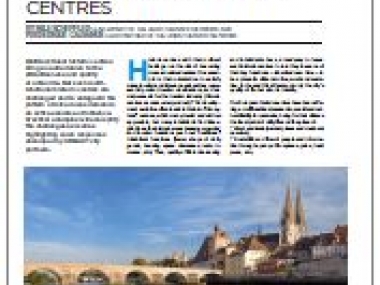The Challenges of Multifunctional Historic Centres
Edited on
09 October 2017Historic cities have always been multifunctional centres; this feature is an added value to the attractiveness and quality of urban life but it is also today a challenge. Read the article "Ready-to-live multifunctional historic centres" and discover practical examples and responses developed by URBACT city partners related to the development of historical city-centres. Published in the ![]() Download The Urbact Tribune 2010 (6.21 MB), this article was written by Nils Scheffler, Lead Expert of the HerO project and Frédérique Calvanus, Lead Partner of the LINKS project.
Download The Urbact Tribune 2010 (6.21 MB), this article was written by Nils Scheffler, Lead Expert of the HerO project and Frédérique Calvanus, Lead Partner of the LINKS project.

The challenge of adapting to conflicting uses Today, historic centres have to respond to clashing demands from the groups that live in and use the city. Unfortunately, the aspiration of a qualitative urban life from their inhabitants, the expectation of an efficient offer of services from tourists and finally the request to get profitable conditions for commercial expansion from businesses often appear as irreconcilable.
The challenge is simple: on the one hand historic centres need to preserve their inherited urban identity; on the other, they have to turn it into a prime resource to fulfil these competing demands.
According to Nils Scheffler and Frédérique Calvanus, in this context the ability of the public administration and its partners to drive a local integrated approach, based on an integrated development concept for the historic city, comes out as an underlying strength. Such policy should be supported by a flexible management system that continuously adapts to new emerging needs.
HERO: integrated strategies for the development of historic centres
The article draws on the work of the URBACT Project HerO which aims to develop management strategies for historic cities to reach the right balance between the preservation of built cultural heritage; attractiveness and competitivity. One of the main issues the 9 partner cities deal with is how to reach the balance of urban functions to secure multifunctionality and attractiveness of their historic urban quarters.
To reach this objective, each city partner develops a Cultural Heritage Integrated Management Plan (CHIMP): an integrated and implementation-oriented concept for the protection and development of the historic centre. This plan defines the vision, guidelines, objectives, actions and management system to safeguard the cultural heritage and the mixed-use character of the area. Eight main fields of actions have therefore been identified: the physical and cultural heritage, culture and tourism, the economy, housing and the living environment, mobility and accessibility, urban design, environment and leisure, awareness raising and research.
LINKS: Developing a sustainable housing environment
The URBACT Project LINKS focuses on building a sustainable and desirable housing environment in urban centres by combining patrimonial and environmental qualities. Within this project, 9 cities work on tackling the progressive imbalance between residential functions and "attraction" functions in historic centres.
Facing growing constraints related to tourism, many historic centres' inhabitants have chosen to move to the suburbs in search for a better quality of life. This flow carries increases pendular mobility that creates dysfunctions and damages the environment. The necessity for historic centres to win their population back has become clearer and therefore the necessity to improve housing offer.
Discover in this article how LINKS city partners, starting by trying to answer the simple question: "Why live in a historic centre?", have developed clever practices to eliminate obstacles to the comeback of urban centre's inhabitants.
Read more:
 Download The Urbact Tribune 2010 (6.21 MB) (page 35) - URBACT Website
Download The Urbact Tribune 2010 (6.21 MB) (page 35) - URBACT Website- HERO - URBACT Website
- LINKS - URBACT Website
- Cultural Heritage and City Development - URBACT Website
Submitted by admin on




